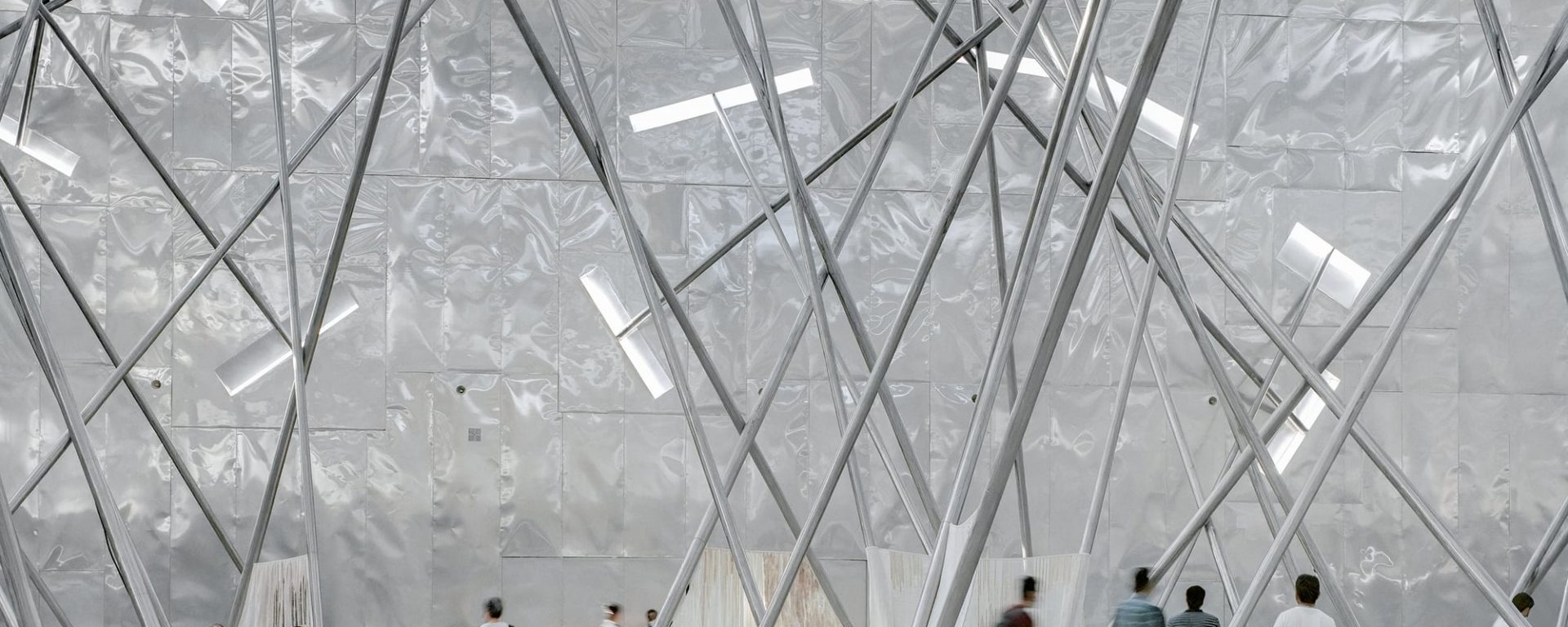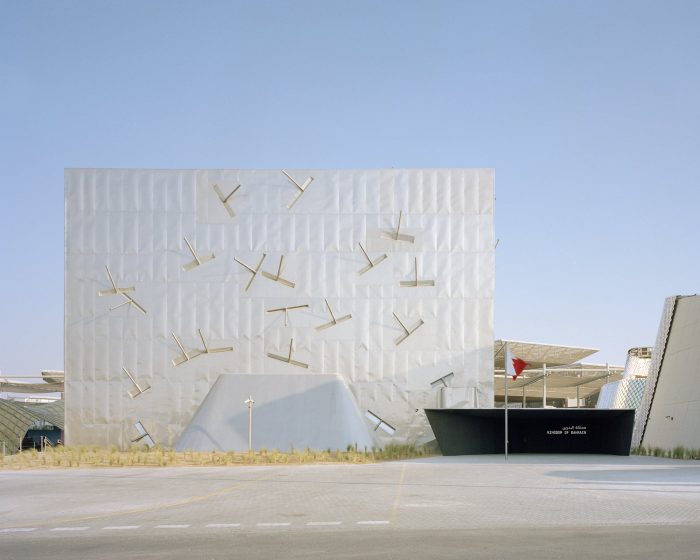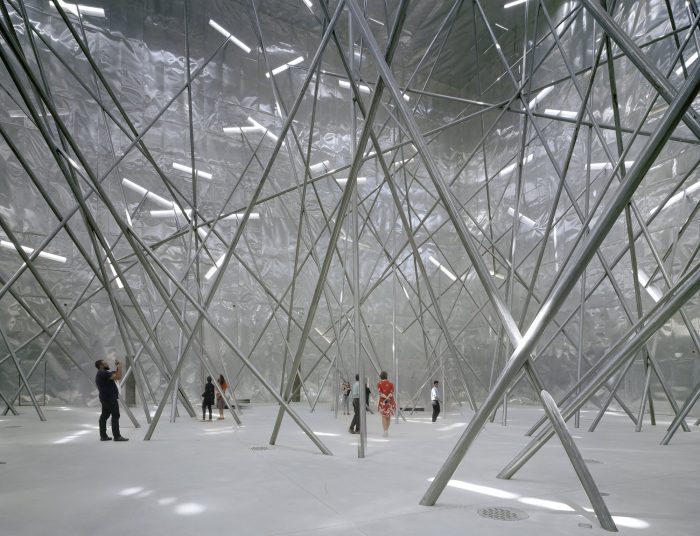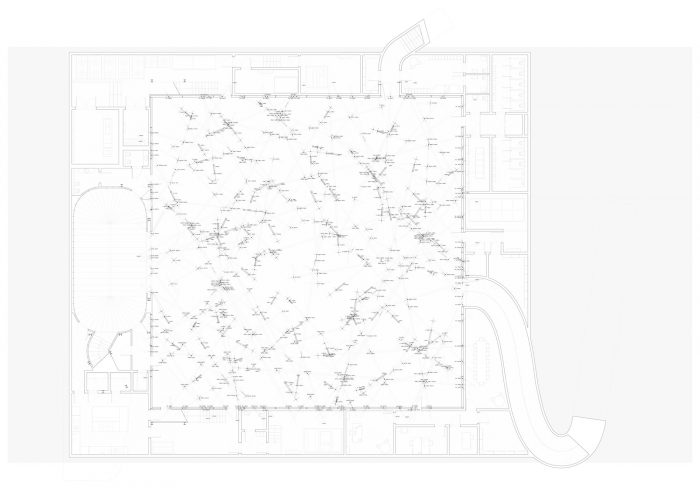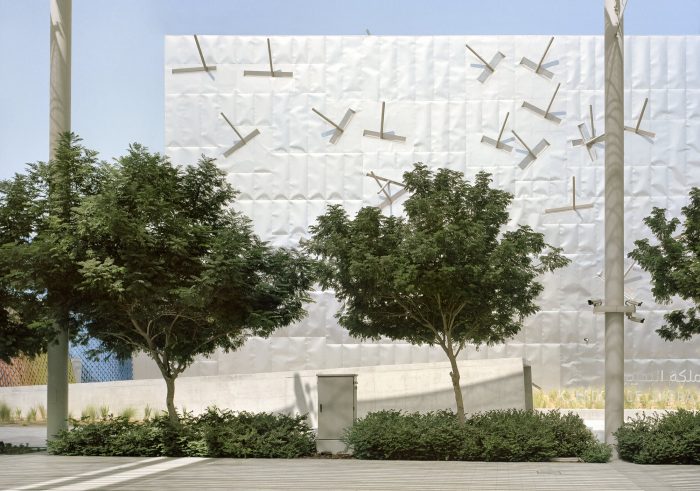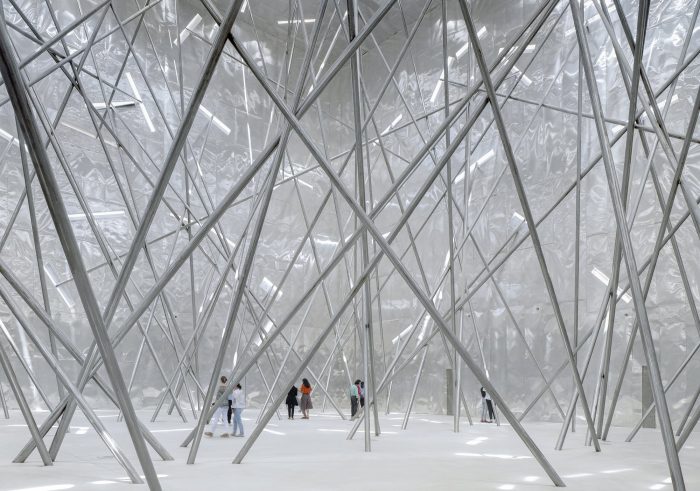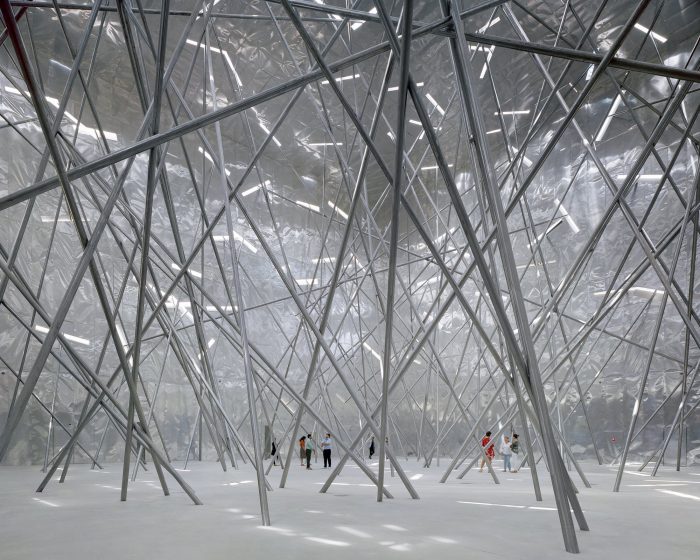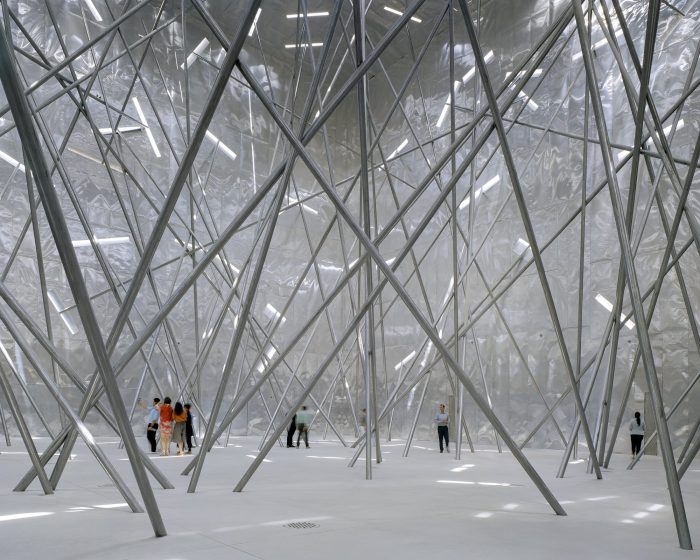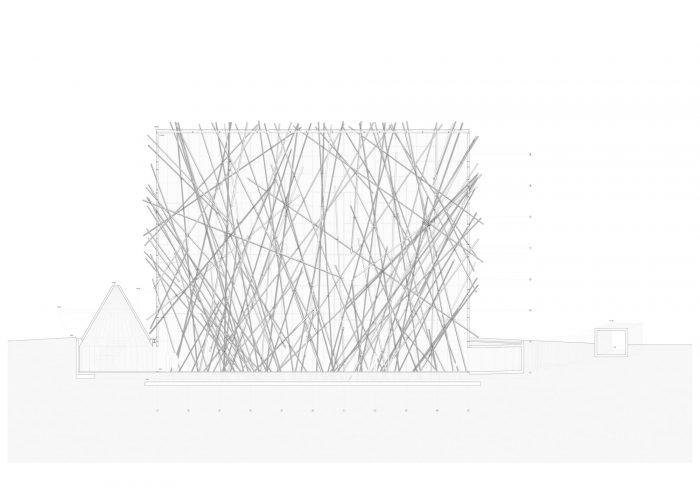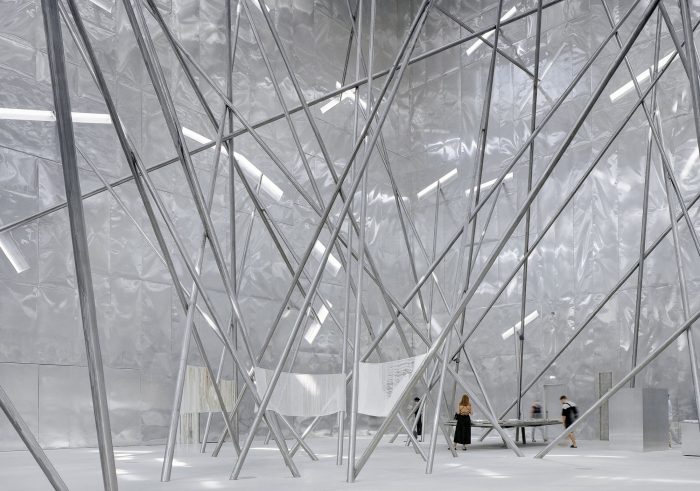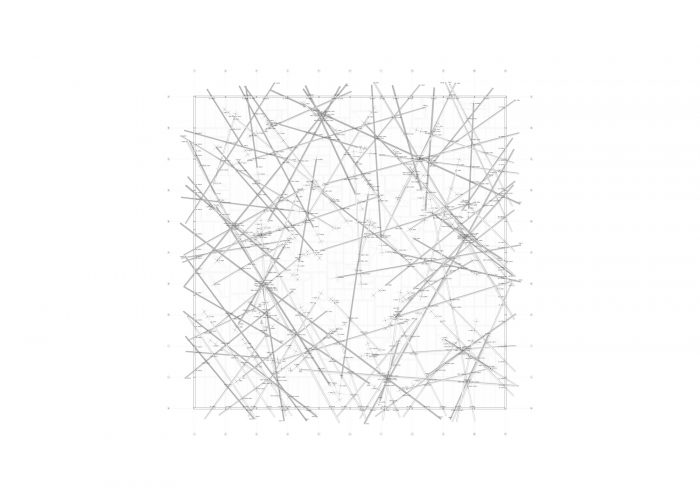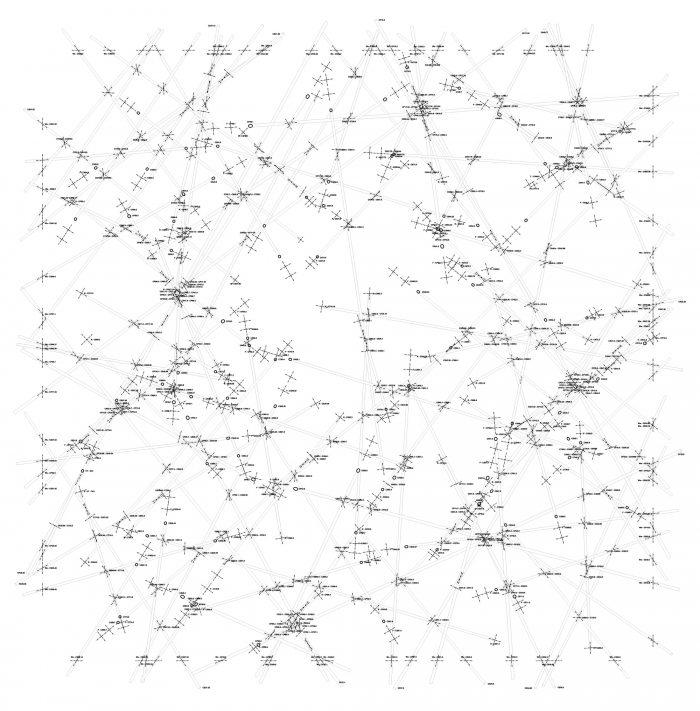迪拜馆由一个面积为900平方米、高约23米的大厅组成。柱子和梁通常在水平和垂直方向上衔接建筑空间,但在这里,柱子向各个方向深不可测地展开。它们穿透墙壁和天花板,在建筑外结束。在薄薄的周边平面上,窗户和窗帘的位置是柱子的几何排列的一个纯粹结果。
The pavilion in Dubai consists of a hall with a floorplan area of 900 m2 and a height of about 23 m. Columns and beams ordinarily articulate architectural space horizontally and vertically, but here the columns spread out unfathomably in all directions. They penetrate walls and ceilings and end outside the building. The placement of the windows and the window reveals in the thin perimeter planes is a pure consequence of the geometrical arrangement of the columns.
同时,这种光源形成了承重,加强了周围墙壁和柱子之间的连接。倾斜的柱子在空间反复相遇,当它们相遇时,它们被焊接在一起。这大大减少了它们与空间的实际尺寸有关的屈曲长度,这意味着房间可以完全由直径为11厘米的丝状标准钢型材来支撑和加固。墙壁是由14厘米薄的U型板制成的框架建造的。它们一起作为一个单一的结构系统工作。
At the same time, this source of light forms the load-bearing and stiffens the connection between the surrounding walls and the columns. The slanted columns meet repeatedly in space and when they do, they are welded together. This drastically reduces their buckling length in relation to the actual dimensions of the space, which means that the room can be supported and stiffened solely by filigree standard steel profiles with a diameter of 11 cm. The walls are built with frames made of 14 cm thin U-profiles. Together, they work as one singular structural system.
虽然这些细柱子从总体上看非常密集,但当你走过建筑空间时,你会发现它们是如此的轻巧和稀少。乍一看,支撑结构看起来好像是均匀地分布在整个空间里,但在整个空间的广阔范围内,视野却反复地打开。此外,密密麻麻的柱子区域与完全没有支撑物的开放区域交替出现。
While the thin columns seem extremely dense in overview, it is quite surprising how light and sparingly placed they appear, on walking through the built space. At first glance, the supporting structure deceptively looks as if it were evenly distributed throughout but vistas open up repeatedly across the entire expanse of the space. In addition, areas of densely spaced columns alternate with open areas that are completely free of supports.
整个大厅的许多开放视野得到了无限的补充,因为人们的视线沿着支撑物反复被吸引到房间的高度和广度上,并通过光线缝隙看到大厅的墙壁和其他地方。围墙的框架是用薄的、可塑性强的铝板包覆的,将边界溶解为多种反射。外部包层的面板也通过略带凸起的表面的反射,再现了下面的薄框架网格。
The many open vistas throughout the hall are complemented by an infinite variety of additional views as the eye is repeatedly drawn up along the supports into the height and expanse of the room to the walls of the hall and beyond via the light slits. The frames of the enclosing walls are clad in thin, malleable aluminum panels, dissolving the boundaries into multiple reflections. The panels of the exterior cladding also reproduce the thin frame grid underneath through the reflections of the slightly cambered surfaces.
在大多数建筑中,支撑结构的唯一目的是支撑建筑,但在这个案例中,它变成了一个定义空间的建筑事件和一个不能轻易解读的空间体验。它不是说明性的。这种不寻常的、未来主义的空间效果并不明确指的是巴林王国,但允许开放的联想领域,例如,穆哈拉克古老宫殿的平面类型,他们内敛的生活空间,到巴林密集的、不规则的、传统的装饰品,但也有最先进的技术,如F1赛车中使用的技术。
In most buildings, the support structure serves the sole purpose of shoring up the building, but in this case, it becomes a space-defining, architectural event and a spatial experience that cannot be readily deciphered. It is not illustrative. This unusual, futuristic, spatial effect does not refer explicitly to the Kingdom of Bahrain, but allows open fields of association, for example, the floor plan typologies of old palaces in Muharraq, their introverted living spaces, to the dense, irregular, traditional ornaments in Bahrain, but also to state-of-the-art technologies such as those used in Formula 1.
巴林文化和文物局在谢哈-迈-宾特-穆罕默德-阿勒哈利法阁下和她的主管努拉-萨耶的指导下,将这个建筑与安妮-霍尔特罗普为米兰世界博览会设计的建筑联系起来,因为他们相信,建筑不仅作为一个物体般的象征很重要,最重要的是它应该给参观者带来独特的建筑和空间体验。这个展馆将在巴林的现代商业中心麦纳麦进行重建,完全本着可持续发展的精神。
The Bahrain Authority of Culture and Antiquities, under the direction of H.E. Sheikha Mai Bint Mohammed Al-Khalifa and her director Noura Al Sayeh, relates this building to Anne Holtrop’s building for the World’s Fair in Milan, for they are convinced that architecture is not only important as an object-like symbol but above all that it should give visitors a unique architectural and spatial experience. This pavilion will be reconstructed in Manama, the modern business center of Bahrain, entirely in the spirit of sustainability.
Architects: Christian Kerez
Area : 2000 m²
Year : 2021
Photographs :Maxime Delvaux
Building Systems Engineer : WANDERS WERNER FALASI Consulting Architects
Lighting Design : Studio Siegrun Appelt with Mathias Burger
Project Architect : Bartosz Bukowski
Project Team : Caio Barboza, Giovanni Dorici, Kacper Karpinski, Zhekun Tang, Zexu Chen
Column Connection Scripting : Alden Studios
General Contractor : Rimond Middle East General Contracting LLC
City : Dubai – United Arab Emirates
Country : United Arab Emirates

